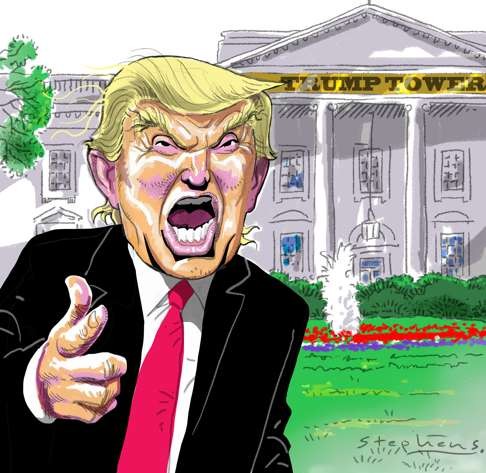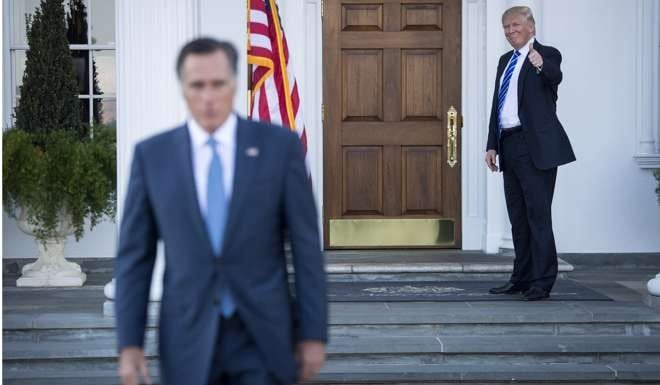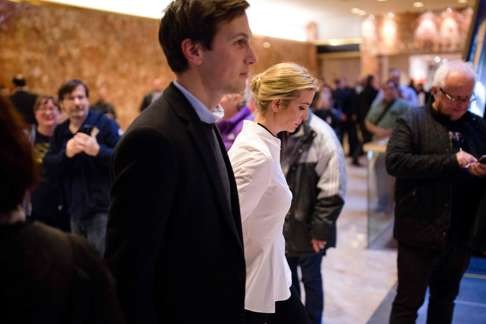
The making of Trump House: how the US president-elect is putting his brand on the White House
Kevin Rafferty says when the next leader of the free world is a freewheeling businessman who goes with his gut instincts, the rest of the world can expect the unexpected


Trump released a two-minute-37-second YouTube video of himself declaring his plans for his first 100 days, promising to “make America great again” by “putting America first. “Whether it’s producing steel, building cars or curing disease, I want the next generation of production and innovation to happen right here, in our great homeland America, creating wealth and jobs for American workers.”
He would withdraw from the Trans-Pacific Partnership, “a potential disaster for our country”, and remove energy restrictions, investigate visa abuse and start to “drain the swamp” of Washington by imposing a five-year ban on officials becoming lobbyists.
Notable omissions from the video are getting rid of Obamacare, throwing out millions of undocumented immigrants, building the great wall of America to keep out Mexicans and other illegals, imposing tough checks on Muslims, bashing China, or revising military alliances with South Korea, Japan or Europe. It may be that his two-and-a-half-minute attention span did not stretch to such weighty issues.
Later, Trump spent a revealing hour at The New York Times headquarters. Tweets from the meeting showed changes from Trump’s claims on the campaign trail. Among them:
• Climate change is not a Chinese hoax.
• He is inclined not to prosecute his opponent Hillary Clinton.
• He expressed doubts about the value of torturing terrorism suspects.
• He distanced himself from the white nationalists celebrating his victory.
On the other hand, he strongly backed his controversial chief strategist Stephen Bannon, calling him “a decent guy”. In typically boastful mood, Trump told the paper’s publisher that he was confident about becoming president: “It’s a very overwhelming job, but I’m not overwhelmed by it.”
Trump denied any conflict of interest between his business empire and his new job as president. “The law’s totally on my side,” he claimed. “The president can’t have a conflict of interest.”
Trump’s business empire, active in 25 countries, is dominated by real estate. It cannot easily be dealt with in the traditional way by setting up a blind trust, and he’s adamantly opposed to selling it off.
Another complication is that Trump plans to let his children run the business empire, but those same children are key political advisers. Trump family members are 25 per cent of his transition team. Trump’s daughter, Ivanka, and her husband, Jared Kushner, were present when Trump met Japan’s prime minister, Shinzo Abe. Trump suggested to The New York Times that Kushner could make peace between Israelis and Palestinians.
Trump’s rule is being done through social media, not conventional public announcements or press conferences. It was bizarre to see reporters of the Old Grey Lady, as The New York Times is known, using breathless Twitter feeds to tell the world about Trump’s pronouncements.
Reporter Mike Grynbaum tweeted that Tom Friedman asked Trump whether he would withdraw from climate change accords. Trump responded: “I’m looking at it very closely.” Pressed whether there is a link between human activity and climate change, he replied, “I think there is some connectivity. Some, something. It depends on how much.” Trump added that he was thinking about “how much it will cost our companies” and the effect on US competitiveness.
He claimed that he had changed his mind about the value of waterboarding after talking to retired Marine Corps general James Mattis, who impressed Trump by saying that building trust was better than torture.
Meanwhile, Trump continued his undisciplined Twitter feed, including damning the cast of the musical Hamilton for daring to issue a plea for tolerance to Vice-President-elect Mike Pence when he attended the show, and advising the UK to appoint ultranationalist Nigel Farage as its ambassador to Washington.
Our wonderful future V.P. Mike Pence was harassed last night at the theater by the cast of Hamilton, cameras blazing.This should not happen!
— Donald J. Trump (@realDonaldTrump) November 19, 2016
The Theater must always be a safe and special place.The cast of Hamilton was very rude last night to a very good man, Mike Pence. Apologize!
— Donald J. Trump (@realDonaldTrump) November 19, 2016
The cast and producers of Hamilton, which I hear is highly overrated, should immediately apologize to Mike Pence for their terrible behavior
— Donald J. Trump (@realDonaldTrump) November 20, 2016
After Fidel Castro’s death, he announced that he would roll back President Barack Obama’s thaw in relations with Cuba to seek “a better deal”.
Trump also boasted he had won the popular vote even though the count shows Hillary Clinton ahead by more than two million votes. He claimed – without any evidence – that “serious voter fraud” had given Clinton “millions” of illegal votes.
Trump is proving that the Oxford dictionary was right to make “post-truth” its word of the year.
As for his cabinet appointments, some of them belie his promise to be a president for all Americans. The most controversial – apart from right-hand man Bannon – is the appointment of former three-star general Mike Flynn as national security adviser, who once described Islamism as “a vicious cancer inside the body of 1.7 billion people”.

Leading Republicans, many previously critical of Trump, have lapped up the idea of a reformed president. Mitt Romney, defeated by Barack Obama in 2012, has variously called Trump “a phoney” and “a fraud”. This same Romney met Trump and is keen to be secretary of state.
In spite of the deliberate chaos of the way Trump works, the stock market has reached new records and has gained 4 per cent since his victory, potting more money for rich people, including Trump himself, who are the antithesis of impoverished Americans who voted him into power.
For all the claimed reformed attitude, it is hard to pin Trump down or extract bankable promises from any of his recent comments; they had all the firm shape of Jell-O thrown against a wall. Just to take climate change, Trump’s key energy advisers are deniers, some dedicated to making “the moral case for fossil fuels”.
A leading supporter claimed that Trump “does not Hoover up information”, meaning he does not study documents or detailed arguments. He has reportedly refused to read most of the daily intelligence briefings he now gets. He prefers to go with his gut feelings and rely on close family and friends, the art of the consummate dealmaker.
What’s a conflict of interest between friends? Welcome to the Trump House, previously known as the White House.
Kevin Rafferty is a political commentator
